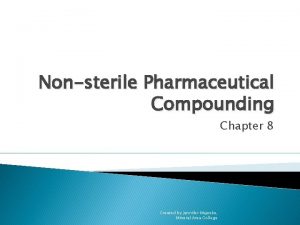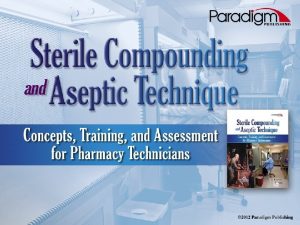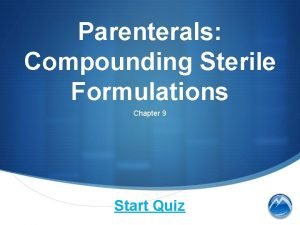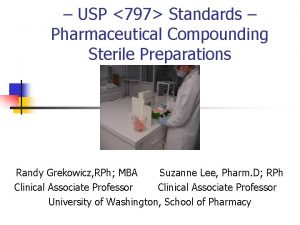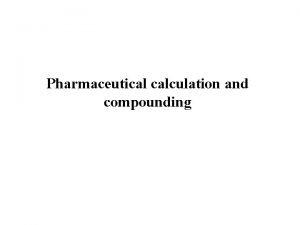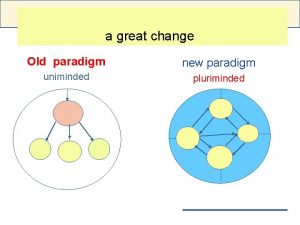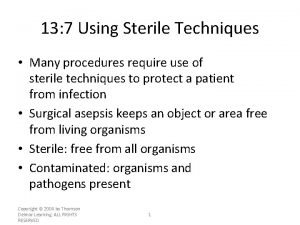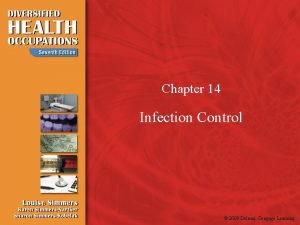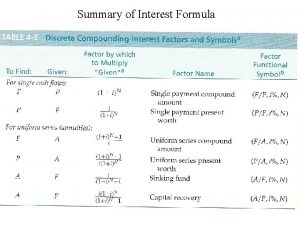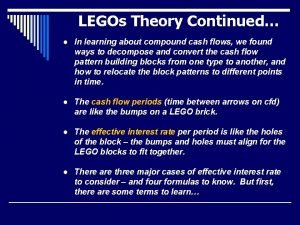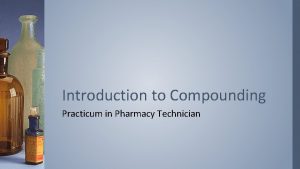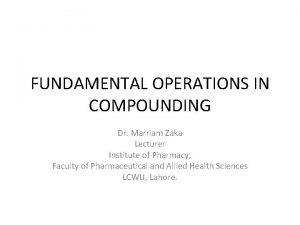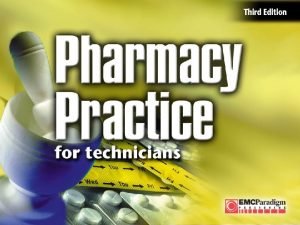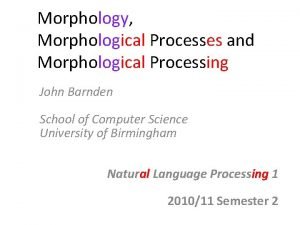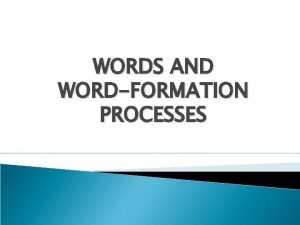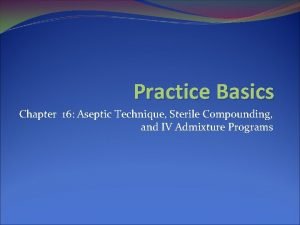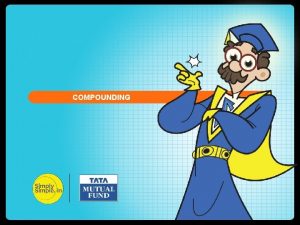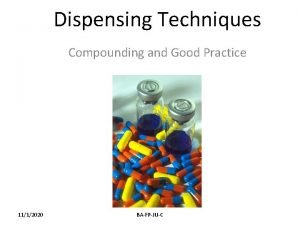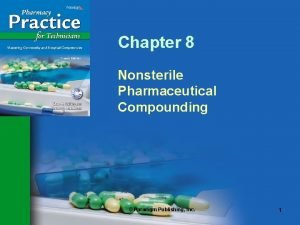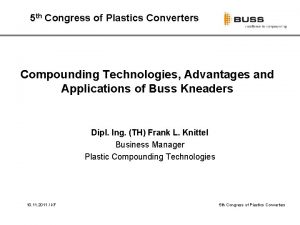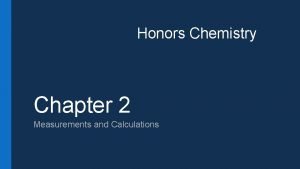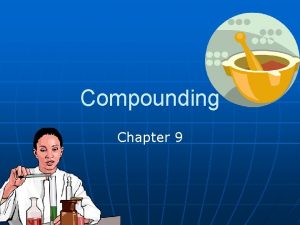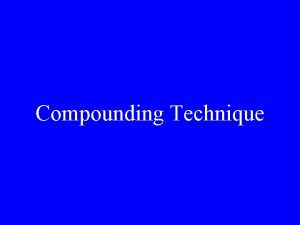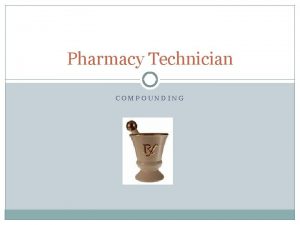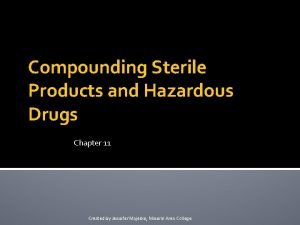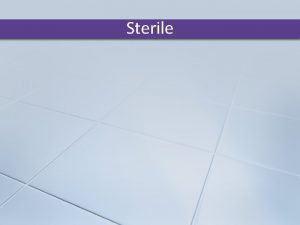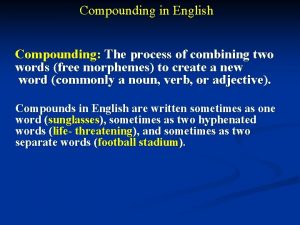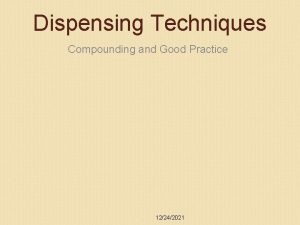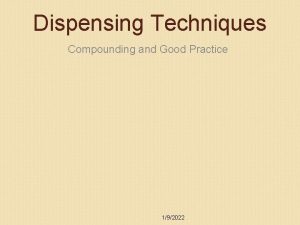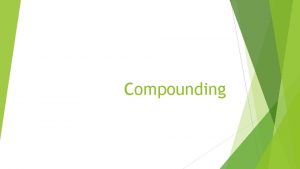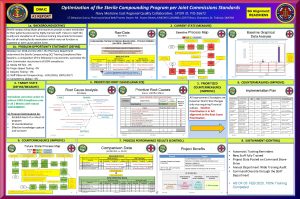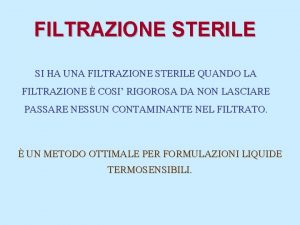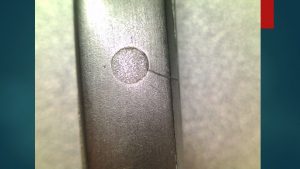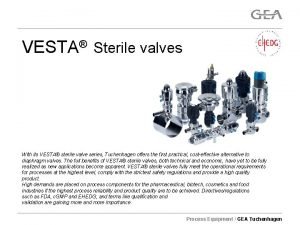Chapter 5 Calculations for Sterile Compounding 2012 Paradigm











![Special Considerations Ø One consideration is that the volume (in milliliters [m. L] or Special Considerations Ø One consideration is that the volume (in milliliters [m. L] or](https://slidetodoc.com/presentation_image/2a41caa96347b61c287a23bd158da549/image-12.jpg)

























- Slides: 37


Chapter 5 Calculations for Sterile Compounding 2012 Paradigm Publishing 2 Topics

Learning Objectives ü Explore the evolution of mathematical formulas used in sterile compounding. ü Understand the principles of pharmacy dosage calculations. ü Practice several types of pharmaceutical calculations using a basic formula, ratio and proportion, dimensional analysis, intravenous flow rates, intravenous drip rates, and alligations. ü Determine the best method of solving pharmaceutical dosage questions based on the medication labeling and sterile compounding procedure required. 2012 Paradigm Publishing 3 Topics

Topics Learning Objectives Introduction Calculations as Part of the Anteroom Protocol Dosage Calculations Special Considerations Common Pharmacy Equivalents and Conversions Basic Formula Calculations In Slide Show view, click Ratio and Proportion Calculations the desired topic to the left to link directly to the Dimensional Analysis Calculations related slide. To return to this slide at any point IV Flow Rate Calculations in the presentation, click the Topics button below. IV Drip Rate Calculations Alligation Calculations Calculation Skills in the Sterile Compounding Environment Chapter Summary 2012 Paradigm Publishing 4 Topics

Introduction Ø The majority of the CSPs assembled will require the application of one or more pharmacy calculation methods to determine the volume of the medication, additive, or solution component needed to prepare a CSP or to resolve the number of CSPs necessary for a 24 -hour supply vnumerous other calculation methods are used by pharmacy personnel to determine information such as day’s supply, quantity to be dispensed, and average wholesale price (AWP) 2012 Paradigm Publishing 5 Topics

Calculations as Part of the Anteroom Protocol Ø The prescriber includes the names of the desired medications, the desired doses, and the dosing intervals as part of the CSP order vthe prescriber also determines the desired base solution and infusion rate for large-volume parenterals (LVPs) vmost small-volume parenterals (SVPs), however, are prepared using standard base solutions and volumes and are administered using standard administration times 2012 Paradigm Publishing 6 Topics

Calculations as Part of the Anteroom Protocol…/2 Ø Once the medication order is received, personnel then enter the information into the computer system and generate a label for each CSP vthe pharmacist and IV technician must verify that the CSP label matches the medication order and is 100% accurate 2012 Paradigm Publishing 7 Topics

Calculations as Part of the Anteroom Protocol…/3 Ø Looking for words or abbreviations that identify a number, dose, volume, amount, or route can help in identifying the medications needed for sterile compounding 2012 Paradigm Publishing 8 Topics

Calculations as Part of the Anteroom Protocol…/4 2012 Paradigm Publishing 9 Topics

Dosage Calculations Ø The calculations are based on information on the CSP label and the label on the stock medication container vbegin the calculation process by determining the concentration; this information can be found on the medication label vthese calculations determine the drug volume 2012 Paradigm Publishing 10 Topics

Dosage Calculations…/2 Ø Locating and understanding label information is an important initial step in ensuring accuracy in pharmacy calculations and in sterile compounding 2012 Paradigm Publishing 11 Topics
![Special Considerations Ø One consideration is that the volume in milliliters m L or Special Considerations Ø One consideration is that the volume (in milliliters [m. L] or](https://slidetodoc.com/presentation_image/2a41caa96347b61c287a23bd158da549/image-12.jpg)
Special Considerations Ø One consideration is that the volume (in milliliters [m. L] or liters [L]) and strength (in percent [%]) of the base solution are not to be included in any equation in which personnel are asked to determine the amount or volume of drug that is to be drawn up for a desired dose Ø Another consideration when performing pharmacy calculations is that an IV technician chooses a method or formula based on the type of CSP being prepared as well as a personal calculation preference 2012 Paradigm Publishing 12 Topics

Common Pharmacy Equivalents and Conversions Ø In addition to understanding basic math principles, the IV technician must memorize the most commonly used equivalents and metric conversions 2012 Paradigm Publishing 13 Topics

Common Pharmacy Equivalents and Conversions…/2 2012 Paradigm Publishing 14 Topics

Common Pharmacy Equivalents and Conversions…/3 2012 Paradigm Publishing 15 Topics

Common Pharmacy Equivalents and Conversions…/4 Ø Sterile compounding personnel must also memorize the conversions from standard time (clock time) to military time 2012 Paradigm Publishing 16 Topics

Your Turn 1) For dosage calculations, begin the calculation process by determining this. In Slide Show view, a. weight click here to see the b. volume answer to Question 1. Then c. concentration click again to advance to d. thickness Question 2. 2) Standard time is called this. a. regular time b. clock time c. average time d. military time 2012 Paradigm Publishing In Slide Show view, click here to see the answer to Question 2. 17 Topics

Basic Formula Calculations Ø The basic formula method is a simple process to calculate most parenteral medication dosages and may be used when the concentration on the drug label is provided in units per one milliliter Ø D/H = x m. L v. D = desired dose v. H = concentration on hand vx = unknown volume of drug needed to be drawn up 2012 Paradigm Publishing 18 Topics

Basic Formula Calculations…/2 Ø The basic formula method is best used in sterile compounding scenarios that meet the following criteria: vthe prescriber has ordered a CSP with a single medication additive vthe drug is in an injectable form vthe medication label provides you with the concentration of the drug in the form of number of units per one milliliter 2012 Paradigm Publishing 19 Topics

Basic Formula Calculations…/3 Performing a Basic Formula Calculation 1. Find the desired dose (D) 2. Determine the concentration on hand (H) 3. Divide D by H The resulting answer equals x m. L 2012 Paradigm Publishing 20 Topics

Ratio and Proportion Calculations Ø The ratio and proportion method may be used whenever three of the four values in a proportion are known, thus allowing the IV technician to solve for the fourth, unknown value of the proportion Ø H mg = D mg Y m. L x m. L v. H mg = number of milligrams on hand v. Y m. L = number of milliliters in the concentration on hand v. D mg = desired dose vx m. L = unknown volume of drug needed to be drawn up 2012 Paradigm Publishing 21 Topics

Ratio and Proportion Calculations…/2 Ø The ratio and proportion method is best used in sterile compounding scenarios that meet the following criteria: vthe stock drug is already in a liquid, injectable form (does not need to be reconstituted; the medication label identifies the concentration of the drug in a form other than the form milligrams per one milliliter vthe stock drug is in a powdered form and requires reconstitution prior to drawing it up for injection veither a liquid or powdered drug requires the completion of several additional steps to solve the problem 2012 Paradigm Publishing 22 Topics

Ratio and Proportion Calculations…/3 Performing a Ratio and Proportion Calculation 1. Set up the ratio 2. Cross-multiply Y × D 3. Divide the answer from step 2 by H Ø The resulting answer equals x m. L 2012 Paradigm Publishing 23 Topics

Dimensional Analysis Calculations Ø The dimensional analysis method, also known as “calculation by cancellation, ” is another approach that some IV technicians prefer to use when a dosage calculation involves multiple steps vbased on the principle that any number can be multiplied by one without changing its value vfirst determine the answer that is needed, and then use the values provided to perform a series of calculations 2012 Paradigm Publishing 24 Topics

Dimensional Analysis Calculations…/2 Ø The dimensional analysis method for solving pharmacy dosage calculations is best used in sterile compounding scenarios that meet either of the following criteria: vto determine the volume of drug needed to prepare the CSP, the IV technician must answer several questions by performing multiple calculations vthe IV technician must make one or more conversions between various units of measure 2012 Paradigm Publishing 25 Topics

Dimensional Analysis Calculations…/3 Ø Performing a Dimensional Analysis Calculation vput the unknown quantity (the x you want to define) on its own on the left side of the equation, followed by an equal sign von the right side, record a series of ratios, using both standard equivalents and information provided by the medication label and the CSP label vthen multiply the ratios together to provide the answer to the problem 2012 Paradigm Publishing 26 Topics

Dimensional Analysis Calculations…/4 Ø The unit of measure in the numerator of the first ratio must be the same as the unit of measure you are solving, and the unit of measure in each successive numerator must match the unit of measure in the preceding denominator vas a result of this setup, the units of measure in each alternate numerator–denominator will cancel out, such that the only unit of measure remaining is the one you must solve 2012 Paradigm Publishing 27 Topics

IV Flow Rate Calculations Ø A daily IV run, or the batch typically requires a 24 -hour supply of CSPs Ø Several types of IV flow rate calculations will determine the answer to one or more of the following: v. How long will this bag last? v. What time will the next bag be needed? v. How many bags will be needed for the patient for a 24 -hour period? Ø These may all be solved using IV flow rate calculations that employ simple addition, division, and/or multiplication 2012 Paradigm Publishing 28 Topics

IV Flow Rate Calculations…/2 Ø The three methods for solving IV flow rate questions are best used in sterile compounding scenarios that meet the following criteria: vthe infusion rate in m. L/hour is provided on the medication order or CSP label vthe total volume is provided on the medication order or CSP label vthe current time is known or may be easily determined 2012 Paradigm Publishing 29 Topics

IV Flow Rate Calculations…/3 Performing an IV Flow Rate Calculation Ø The answers to the three questions can be determined by setting up a division or multiplication problem vwhen calculating IV flow rates, you must know the total volume of the LVP and either 1) the infusion rate in milliliters per hour (m. L/hr) or 2) the number of hours over which the LVP is to be infused vthis information can be found on the medication order or the CSP label 2012 Paradigm Publishing 30 Topics

IV Drip Rate Calculations Ø The drop factor method relies on the specific drop factor (gtts/m. L), or the number of drops per milliliter, that a certain type of IV tubing delivers Ø Each of the different types of IV tubing delivers a different drop factor vmacrodrip IV tubing may deliver either 10 gtts/m. L or 20 gtts/m. L vmicrodrip IV tubing delivers 60 gtts/m. L Ø An equation using drop factor is sometimes called an IV drip rate calculation 2012 Paradigm Publishing 31 Topics

IV Drip Rate Calculations…/2 Ø The drop factor method is best used in situations that meet the following criteria: vthe total volume to be infused is known vthe total infusion time is known vthe drop factor of the IV tubing is known vthe desired answer is to be provided in drops per minute (gtts/min) total volume in m. L × infusion time in minutes 2012 Paradigm Publishing drop factor = drops minute 32 Topics

Alligation Calculations Ø The pharmacy may be required to mix two different strengths of the same active ingredient of a drug or solution to make the desired strength va higher-percent strength of a drug or solution is mixed with a lower-percent strength of a drug or solution in order to make the desired strength Ø This scenario requires you to employ a calculation called the alligation method, or simply alligation vrarely performed by IV technicians 2012 Paradigm Publishing 33 Topics

Alligation Calculations…/2 Ø The alligation method of solving pharmacy dosage calculations is best used in compounding situations that meet any of the following criteria: vtwo or more strengths of the same active ingredient or solution must be used to prepare the desired strength of a drug or solution vthe desired strength of the drug or solution is known vthe total volume of the CSP is known 2012 Paradigm Publishing 34 Topics

Alligation Calculations…/3 Performing an Alligation Calculation 1. Identify the variables by determining the component concentrations 2. Fill in the concentration strengths 3. Find the values 4. Set up a ratio 5. Use a formula 2012 Paradigm Publishing 35 Topics

Calculation Skills in the Sterile Compounding Environment Ø Accurate calculation and measurement of the components or ingredients of the formulation are critical vthe pharmacy technician must have an understanding of historical practices and a working knowledge of current systems of measurement and pharmacy calculations vin order to perform accurate calculations, you must write down the equation and verify that you have the correct information in the correct place within the formula 2012 Paradigm Publishing 36 Topics

Your Turn 3) This is the basic formula. a. H/D = x m. L b. X/D = h m. L c. D/H = x m. L d. X/H = d m. L In Slide Show view, click here to see the answer to Question 3. Then click again to advance to Question 4. 4) An equation using drop factor is sometimes called this. a. ratio and proportion calculation b. IV flow rate calculation c. alligation calculation d. IV drip rate calculation 2012 Paradigm Publishing 37 In Slide Show view, click here to see the answer to Question 4. Topics
 Non sterile compounding examples
Non sterile compounding examples Alligation calculator
Alligation calculator Compounding sterile preparations quiz
Compounding sterile preparations quiz Non sterile compounding examples
Non sterile compounding examples Low and medium risk sterile compounding quiz
Low and medium risk sterile compounding quiz Pharmaceutical compounding calculations
Pharmaceutical compounding calculations Old paradigm
Old paradigm Structural steel connection calculations calculations
Structural steel connection calculations calculations Chapter 15:5 sterilizing with an autoclave
Chapter 15:5 sterilizing with an autoclave Chapter 15 infection control
Chapter 15 infection control 15:8 using sterile techniques
15:8 using sterile techniques Chapter 14:3 washing hands
Chapter 14:3 washing hands Chapter 15:4 observing standard precautions
Chapter 15:4 observing standard precautions Usaha konsep compound
Usaha konsep compound Discrete compounding
Discrete compounding Interest compounded daily formula
Interest compounded daily formula Idaily semi
Idaily semi Tool that measures angles
Tool that measures angles Fundamental operations in compounding pdf
Fundamental operations in compounding pdf Define geometric dilution
Define geometric dilution Compounding periods
Compounding periods What does compounding the brakes mean
What does compounding the brakes mean Example of morphological process
Example of morphological process Geometric dilution pharmacy
Geometric dilution pharmacy Blackout compounding or blending
Blackout compounding or blending 3-6 continuous compounding answer key
3-6 continuous compounding answer key Non coring technique
Non coring technique Compounding refers to
Compounding refers to Pe compound air bubble film manufacturer
Pe compound air bubble film manufacturer Dispensing techniques
Dispensing techniques Compounding swap
Compounding swap Compounding refers to
Compounding refers to Compounding spatula
Compounding spatula Lloyd center compounding pharmacy
Lloyd center compounding pharmacy Centrale doorvoer graafmachine
Centrale doorvoer graafmachine Hffr self compounding
Hffr self compounding 3-6 continuous compounding
3-6 continuous compounding Chapter 2 measurements and calculations
Chapter 2 measurements and calculations
